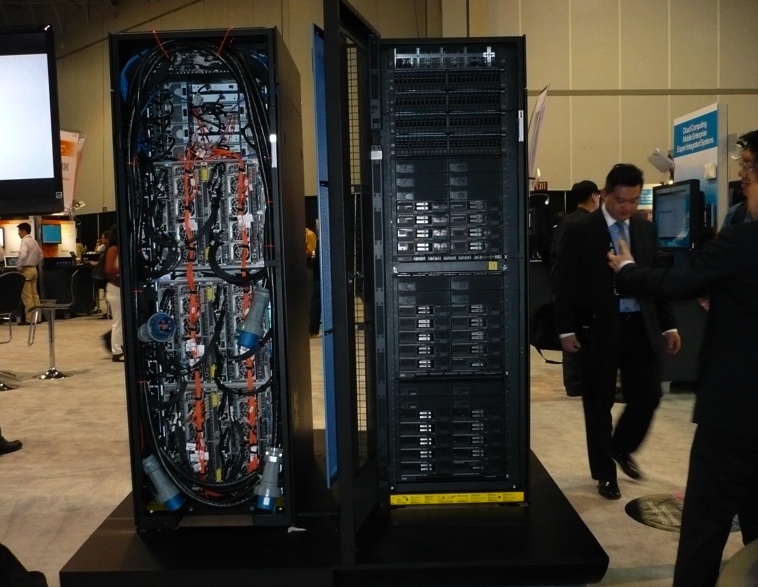Did you followed IBM closely in 2012? If you did, you would (should) have come across PureSystems, a new approach to computing that is set to radically redefine the economics of IT.
PureSystems introduces a new approach to IT system design, procurement, lifecycle management and retirement. Systems are designed and optimized in the factory for a particular set of related tasks (workloads) and are not meant to be general purpose or highly customizable. Generally, they have a static,
predefined stack of hardware and software that cannot be altered.
Where the system design does not meet the needs of a particular use case, other custom solutions may be more appropriate.
So why design a system with such "limitations" ?
As it turns out, more is less in this instance. PureSystems are purpose-built systems that are intended to be easy to setup, configure and manage. Much of the burden of setting up and managing traditional IT system have been removed or radically simplified, making it possible for clients to adopt highly complex enterprise IT systems without having to understand all the complex internal details. When one looks deeper into the time spent on the phases of implementing IT projects,
it becomes clear that there is significant opportunity for improvement to
accelerate time-to-value. Forrester did some research for IBM which showed that the top causes for delays were related to the time spent integrating, configuration and tuning systems, as well as deploying applications. These are key areas address by PureSystems.
Think for a moment about what Apple did with the original Macs and subsequently the iPod and iPhone. All Apple devices were integrated and optimized in the factory for a well defined set of tasks, the Mac for personal computing, the iPod for multimedia entertainment, and the iPhone for mobile telephony and related functions. Apple was able to optimized the software running on these devices as they understood and tightly controlled the hardware. This enabled them to create a much more pleasing user experience, and this observation is not simply related to the Software Ergonomics, but they way the device feels; its weight, its thickness, the way it looks. There is much more to an Apple device that the functionality it offers, and this in my view, was the one of the triggers for Apple's cult following.
Now, turn to Google's Android. Google's Android operating system is freely available for all to use, and Samsung's innovation has ensured the Andriod operating system remains dominate outside of the USA. While openness and ease of adoption is most certainly a competitive advantage for Android, the loose coupling between the Operating System and the hardware makes it more challenging for Android to achieve the same level of brand specificity as Apple. In the Android world, users have a choice of devices from many players with their very own unique device designs. This does not in any way guarantee Apple's dominance or vice versa. In my view, there are merits in both approaches.
Let's get back to PureSystems...
With PureSystems, IBM has made available, the benefits of both approaches. The "Apple" of PureSystems are the Expert Integrated Systems that ship from the factory pre-racked, with all the storage, compute, networking and middleware software components in place, and ready for use. Like the iPhone, once the system is out of its packaging, you plug it into the power supply, connect it to the network, and go through a mostly automated set up process to initialized the systems and begin installing applications from an internal application store. As with Apple's devices, PureSystems has various offerings designed to address different usage profiles. There is an application system for running transactional web applications, a database system for transactional database applications, and an analytics systems for analyzing large data sets. This is akin to the iPhone, iPad, Mac etc. And as with the iPad and iPad Minis, these also come in different sizes and configurations that are easy to understand and adopt based on the anticipated workload. PureSystems offers the best user experience, enabling IT organisations to adopt enterprise computing capabilities while realizing much faster time to value.
But IBM does not stop there. Recognizing that others might have already invested in hardware from IBM and other vendors, IBM introduced IBM Workload Deployer. A subset of the capability used for installing and life-cycle managing applications in the PureSystems application store is available in IBM Workload Deployer (IWD). With IWD, clients can automate the installation and lifecycle management of applications onto a member of the PureSystems family, PureFlex, a pre-integrated, optimized infrastructure system, as well as other 3rd party and IBM custom built hardware systems. This model is akin to the Android model, where various device manufacturers build and design their custom hardware for the Android Operating System. While the software user experience might be consistent, the physical experience, i.e. the look and feel of the device varies across device manufacturers. So while the Samsung Galaxy S3 might run the Android Operating System as well as the Samsung Galaxy Note or LG, Motorola or any other vendor's device, the total experience is undeniably different.
 In my view, investing in the PureSystems family is akin to investing in a range of Apple devices. The customer service experience, the look and feel, and experience of working with the offering is very consistent across the range of products. If you know how to use one, learning to use the other is relatively easy, when compared to learning something new. Investing in IBM Workload Deployer on the other hand has its advantages. You are able to deploy applications across a hybrid set of hardware infrastructures. This requires IBM, the client or a third-party to configure the hardware platform for use with IWD. Included in the PureSystems family is PureFlex, an offering well positioned for this use case. By acting as a middleware deployment and lifecycle management broker for a range of hardware platforms and operating systems, some of the optimizations possible from tight integration and control of the underlying hardware are not possible. Lifecycle management activities such as hardware firmware patch management would vary between platforms.
In my view, investing in the PureSystems family is akin to investing in a range of Apple devices. The customer service experience, the look and feel, and experience of working with the offering is very consistent across the range of products. If you know how to use one, learning to use the other is relatively easy, when compared to learning something new. Investing in IBM Workload Deployer on the other hand has its advantages. You are able to deploy applications across a hybrid set of hardware infrastructures. This requires IBM, the client or a third-party to configure the hardware platform for use with IWD. Included in the PureSystems family is PureFlex, an offering well positioned for this use case. By acting as a middleware deployment and lifecycle management broker for a range of hardware platforms and operating systems, some of the optimizations possible from tight integration and control of the underlying hardware are not possible. Lifecycle management activities such as hardware firmware patch management would vary between platforms.
In conclusion, it is worth stating that Workload Deployer and PureSystems deliver a comprehensive set of cpabilities that address the need for agility and simplicity in IT services delivery to the business. Where an IT organization is focused on time to value, PureSystems has some distinct benefits, and where there is a need to leverage existing infrastructure investments, IWD is uniquely positioned. We see many of our most innovative clients adopting both systems effectively to transform their IT operations and differentiate themselves over their competitors.




No comments:
Post a Comment